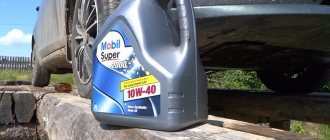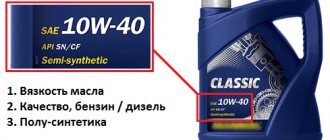Let's start with the fact that not all car enthusiasts know that exceeding the oil level in the internal combustion engine is just as undesirable as underfilling the lubricant. The reason is quite obvious, since everyone knows about the consequences of oil starvation and running an engine without oil. As a result, many firmly believe that the more oil you pour into the engine, the better for the engine. Let us immediately note that this is not so.
Of course, the consequences of overflowing oil into the engine are not so critical for the internal combustion engine, and may not appear immediately. However, they still exist. In some cases, gaskets and seals begin to leak, in others the engine cokes more, excess lubricant gets into various systems, etc.
It should also be added that not all car owners also know how to properly add oil to the engine and check the lubricant level in the engine. For this reason, there are also many underfills and overfills. Next we will talk about what to do if the driver accidentally filled the oil above the level, as well as how to pump oil out of the engine.
Changing oil through a tube
How is the oil changed through the dipstick tube? The procedure itself is easy and takes about 15-20 minutes. Most of the time is spent waiting for the oil to flow from the pan into a special container. There are special installations for changing oil through a dipstick, the cost of which is low. One such installation costs about 1000 rubles.
It is worth noting that many car service centers use this device to change oil through a dipstick, but basically it is ideal for independent use when it is not possible to go to a service station.
How to pump oil out of the engine if draining is impossible?
The only possible way is a vacuum pump. But these are only available at service stations; to use them in the garage, you will have to shell out a tidy sum. You will have to pump it out through the dipstick; the oil filler neck is not suitable for this.
You can make something like a vacuum pump yourself:
- From a pastry syringe. The pressure is low, but the volume is good. You can pump out 200-300 ml in one go.
- From a medical syringe. The situation is the opposite: excellent pressure, but small volume.
- From a rubber syringe or PET bottle with thick walls. If the container is compressed, back pressure is created when the shape is restored.
Device for changing oil through dipstick
This device is quite simple, and its operating principle is based on creating a pressure difference inside and outside the container. It consists of:
- Main tank.
- A pump for pumping air out of the tank and creating a pressure difference.
- A hose through which oil will flow from the oil pan.
The process looks like this:
- Combine all these elements. That is, connect the hose to the tank, insert the pump into it from above.
- Insert the hose into the hole for the oil dipstick until it stops. That is, until the tip of the hose rests on the bottom of the pan. The hose itself is quite thin, so it easily penetrates the hole.
- You pump out the air and create a pressure difference. You need to pump until it becomes hard.
- Afterwards the pump can be removed. Due to the presence of a check valve in the main tank, the pressure inside will not go anywhere. Engine oil will begin to slowly flow into the main tank.
Depending on what viscosity of oil is used and what condition it is in, the process of changing the oil through the dipstick will last about 10-15 minutes. It rarely lasts 20 minutes if the replacement is carried out on a car with a large engine.
Pure experiment
Insert the tube into the hole for the dipstick and connect it to the pump. On the other side we fix the second tube - to drain the oil. We lower its second end into a 5-liter plastic drinking water bottle (a transparent container allows you to control the volume of drained working fluid). We make sure that the pump is turned off, then connect the terminals of the device to the car battery, observing the polarity.
We place the pump in the engine compartment so that it does not fall during operation. It can be noted that the device operates quite quietly.
We place the pump in the engine compartment so that it does not fall during operation. It can be noted that the device operates quite quietly.
Turn on the pump and start pumping. The oil rises through a tube inserted into the dipstick hole, passes through the device and flows out of the second tube into a plastic container.
After a few minutes, the sound made by the oil pump motor changed as the engine became easier to operate. This means the oil has run out. Let's verify this by moving the tube inserted into the probe hole. If the sound of the pump does not change, turn off the device.
Advantages
The advantage of this method is that you do not need to unscrew the lower protection and bolts and drive the car into the pit. At a minimum, this will save money and time, because you won’t have to take the car to a service station to replace fuel and lubricants. All this will take about 5-10 minutes, no more. If you wish, you can even use an automatic pump (not a manual one), which drivers almost always have in case of tire inflation. With it, the oil is pumped out much faster. Actually, these are all the advantages of this method.
Flaws
It is worth noting that changing oil through a dipstick is not perceived in the best way on various forums. Many car owners insist that this cannot be done, although in many service stations technicians resort to this method.
The most basic argument against changing engine oil through a dipstick is that when the engine is running, the oil wears out, and many of its additives, which are necessarily included in the composition, precipitate. All this sediment, including dirt and combustion products of additives, remains at the bottom. When changing the oil through the dipstick with your own hands, it is impossible to get all this sediment from the bottom, and even after the change it will lie there. By pouring in new oil, the old sediment will mix with the new one, and this will lead to the fact that the efficiency of the new oil will be reduced. It is quite logical that with each new pumping through the dipstick, the sediment will remain large, and ultimately this will seriously reduce the service life of the motor. Therefore, the conclusion is this: you can change the oil through the dipstick yourself, but you shouldn’t get carried away with it. At a minimum, it is necessary to make a replacement in the usual way (draining oil from the bottom through the drain bolts) after each fuel and lubricants change through the dipstick, but for what?
Why it is not advisable to pour oil into the engine
When checking the lubricant level in the power unit, a dipstick with the “MIN” and “MAX” parameters marked on it is used. If the volume is exceeded by at least 200-250 ml, this is enough for the oil trace to be above the upper level.
Such situations are a common occurrence, for example, a car owner drove the car after changing the oil. After 20-30 km he decided to check the level and saw that the level was low.
Without thinking twice, the driver adds the required volume, thereby overfilling the liquid above the permissible level.
What is the mistake? When measuring, many violate the main rules of verification:
- carry out measurements on a hot engine;
- do not place the car on a flat surface;
- do not take a 2-5 minute pause before measurements.
In other words, the test is carried out “by eye”. It is not surprising that with this approach, oil overflow is detected.
If the mark is near “MAX”, but does not exceed it, there is no need to worry. Moreover, if the engine is oil-guzzling, the driver will have such foresight, by the way.
Overfilling oil is dangerous for the power unit. Without going into the technical part, the presence of excess lubricant leads to increased pressure in the lubrication system, the appearance of foam and increased load on internal components (oil seals, seals).
While in the summer the problem is easy to overlook, in the winter the oil thickens and the pressure on internal parts increases.
As a result, the seals are squeezed out, seals leak, etc.
Experts' opinion
It is fair to note that some experts do not agree with the opinion that combustion products may precipitate. If you use good oil and change it at least every 10 thousand kilometers, then there can be no sediment. This completely negates the disadvantages of this method. Indirect confirmation of this is the fact that many car service stations have such devices for pumping out oil without the need to remove protection and drain bolts. And since masters resort to this method, this indicates its harmlessness. Also, in some engine models (for example, in boat engines), the oil can only be changed in this way. Structurally, boat engines are not much different from car engines, because they “eat” the same gasoline and use the same oil for lubrication. And since the manufacturer himself provides for changing the oil by pumping it out using a pump, then this can also be done in a car.
The effectiveness of this method
Many owners doubt the effectiveness of changing oil using this method. This is fair, because there is a possibility that not all the oil will be pumped out through the dipstick hole. However, many people carried out a test and first pumped out the oil using a pump through the dipstick, and only then unscrewed the plug at the bottom. It was impossible to collect a single drop of oil from the bottom, so we can confidently confirm the effectiveness of using such installations. Every last drop of oil is pumped out, but sediment may remain at the bottom.
Examination
To understand how effectively the electric pump coped with its task, lift the car on a lift and unscrew the drain plug in the pan. The oil flows out quite intensively. During our last experiment, when we used a vacuum installation for similar work, this did not happen.
We waited until the remaining oil in the system drained completely to assess its volume. Almost 200 ml has been collected!
We waited until the remaining oil in the system drained completely to assess its volume. Almost 200 ml has been collected!
The conclusion is obvious: you should not change the engine oil yourself using an electric pump. And although the device is interesting, it clearly needs improvement.
Secrets of correct replacement
The most important thing when replacing is to warm up the engine to operating temperature and wait 5 minutes until the oil completely drains down. Heated oil is more mobile, so pumping it through the oil change tube through the dipstick will be faster. And if there are any oil production products and additives left at the bottom, they will also mix with fuel and lubricants and easily come out along with the used oil.
The second important point is that the machine must stand on a perfectly flat surface. If it stands at even a slight slope, then it will be impossible to pump out all the oil from the engine, and some of it will certainly remain.
Pump:
The pump is connected using crocodiles (wire length 30 cm):
The kit includes: Copper tube 70 cm (why?);
Silicone hose 120 cm (for drainage); Solid tube 80 cm. Diameter of hoses and copper tube:
Disassembly:
The pump has four removable mounts (to reduce vibration, the mounts are made of rubber):
Membrane part. Everything is symmetrical on both sides. The valves are spring loaded.
Motor with bearing, eccentric flywheel.
Checking the compliance of the characteristics: Measured the current consumption at idle:
Then under load:
Next, I checked how long it would take for the pump to pump 1.75 liters:
The pump pumped approximately 1.75 liters in 30 seconds, which turns out to be 3.5 liters in one minute, which is 1.5 liters less than stated. Initially, the result was even worse, since the tube was of a smaller diameter.
Possible problems
Sometimes it is not possible to use the dipstick to change the oil. Or rather, you can use it, but you still have to drive the car into a pit. In some car models, the oil filter is located near the guard or in a place that cannot be reached from under the hood. And changing the oil without replacing the oil filter is a useless process. Therefore, some car owners may not even think about which replacement method is better, because they will still have to drive the car into a pit, remove the protection and drain bolts from below. Perhaps this is for the best, given the possible sedimentation of oil combustion products.
Pros and cons of changing oil through the dipstick
The advantages of this method are obvious to everyone:
- It's easy to do. There is no need to unscrew the engine protection, remove the drain bolts and first drive the car into the pit. Of course, this does not apply to those cars where you have to crawl under the car to change the oil filter.
- It's free. Once you have purchased such a device, you can use it for a very long time. In this case, you do not need to spend 250-300 rubles for a replacement.
As for the disadvantages:
- There is a possibility that combustion products of additives and oil remain at the bottom. This is not certain, so it cannot be confirmed. The opinions of experts on this matter are contradictory.
- Sometimes it is not possible to pump out all the oil. This is possible if it is very viscous (dense) or the car is on a slope.
- No benefit for cars where the filter is replaced in a pit.










